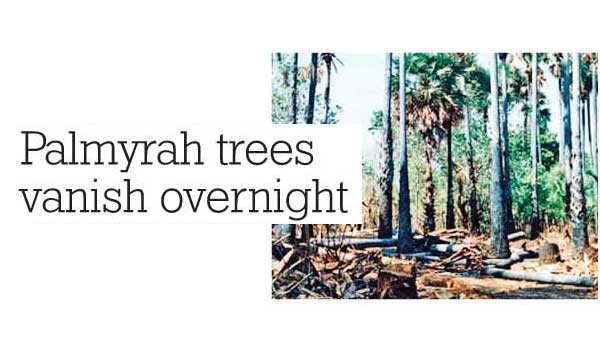
Palmyrah trees vanish overnight

Thousands of Palmyrah trees have been felled and smuggled out of Talaimannar to be sold elsewhere, villagers said. They have demanded that this illegal act should be stopped and legal action should be taken against the culprits.
They complained that a large number of palmyrah trees were being felled in Talaimannar, Olaithoduwai, Kaddukkarankudiyiruppu, Thulukuddiyiruppu, Pesalai and Karisal even during day time and were being smuggled out by night without the knowledge of the owners.
People also complained that unidentified groups are illegally felling palmyrahs on a daily basis and their resources are being robbed.
Source – 15/06/2017, Ceylon Today , See more at – http://www.ceylontoday.lk/article20170401CT20170930.php?id=5403
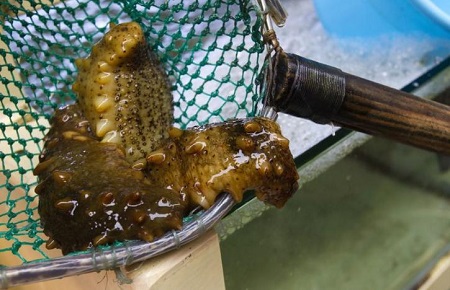
Sea cucumber meant to be smuggled into Lanka seized in Tamil Nadu

Close to 600 kg of sea cucumber, an endangered coral reef species, meant to be smuggled into Sri Lanka was seized in Tamil Nadu and one suspect was arrested inconnection, Marine police told Indian media
According to DNA, acting on a tip-off, a team of Marine Police recovered the sea cucumber hidden in a sack buried off Thiruvadanai coast in this district, and confiscated it this morning, they said.
One Mohammed Wasim of Devipattinam has been arrested in this connection, they added.
Sea cucumbers, which play an important role in maintaining the marine ecological system, have been classified as endangered species and their harvest banned under the Wildlife Protection Act.
Source – 19/06/2017,Times Online, see more at – http://www.sundaytimes.lk/article/1023853/sea-cucumber-meant-to-be-smuggled-into-lanka-seized-in-tamil-nadu
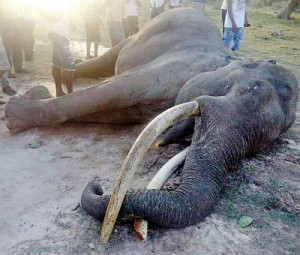
Majestic tusker killed in turf war
The iconic, oldest tusker in the Yala National Park, Thilak, was killed in a tussle with another elephant named Kabila (Thani Dalaya) in Sithulpawwa last Wednesday.
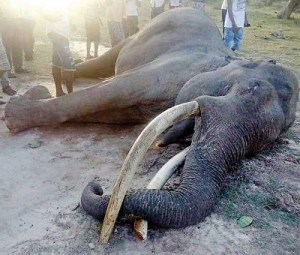
Pic by Samantha Hettiarachchi
As the largest tusker among some 120 tuskers in Sri Lanka, the 60-year-old Thilak was the centre of attraction for tourists who visited Yala. His massive tusks curved inwards in a cross making him well known.
Veterinary physician Dr. Ananda Dharmakeerthi said that heavy injuries to the abdomen during the attack by the other elephant may have led to Thilak’s death.
ocal environmentalists say it is rare for a 20-year-old elephant to take on a tusker as big and senior as Thilak. Former Deputy Director of the Wildlife Department, Dr. Nandana Attapattu, explained that altercations among elephants emerged when they tried to dominate a particular territory.
Dr. Attapattu said as many as 10 tuskers were killed by poachers and hunters in the past.
Source – The Sunday Times,18/06/2017, See more at – http://www.sundaytimes.lk/170618/news/majestic-tusker-killed-in-turf-war-245799.html
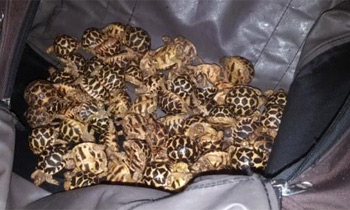
Two arrested for smuggling 2,089 star tortoises from India
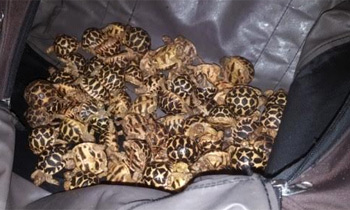
Two suspects had been arrested by the Navy, when they attempted to smuggle in 2,089 living star tortoises by a dinghy, in the seas off Kalpitiya yesterday, the Navy said The suspects were smuggling these rare species of tortoises by illegal means from India, the Navy said. They said suspects were arrested a group of Naval personnel attached to the Northwestern Naval Command following on a tip off. The suspects, the star tortoises, the dinghy and other items were brought to the Naval Base by SLNS Vijaya in Kalpitiya and subsequently handed over to the Sinnapadu Customs Office for onward legal action.
Source -Daily Mirror,18/06/2017 – See more at: http://www.dailymirror.lk/article/Two-arrested-for-smuggling-star-tortoises-from-India-131098.html#sthash.6PVu9Wng.dpuf
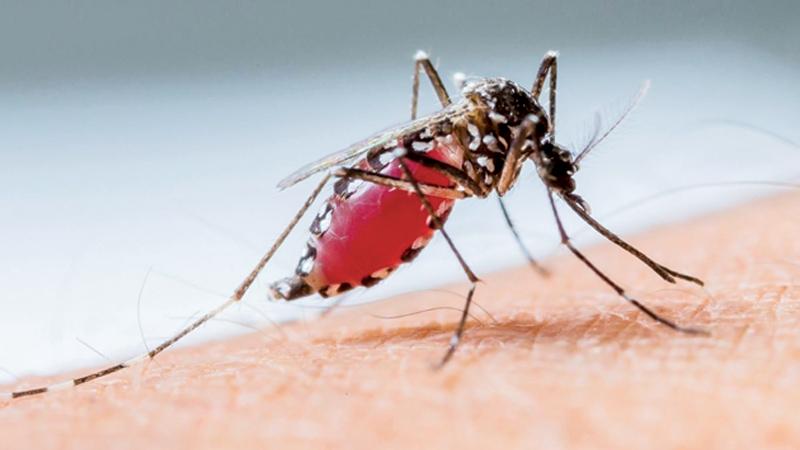
PRECAUTIONS AGAINST DENGUE

The National Anti-dengue Campaign wants people to take following precautions as there is a danger of dengue spreading due to monsoonal rains:
Over-exhaustion while having fever will aggravate dengue.
If fever continues for two days, please seek medical advice. Only paracetamol may be taken for fever.
If you are afflicted with dengue fever, taking other painkillers will cause bleeding and aggravate the condition.
If the following symptoms are visible with high fever you might have contracted dengue: 1.
1.Headache and pain below eyes, 2. Mascular and joint pain, 3.Vomiting, 4. Bleeding conditions, 5. Red patches on the skin.
Worst features:
Likelihood of death for dengue patients who reach the state of shock.
Some patients even before reaching the state of shock will show the following symptoms within 3-7 days of getting fever. Such patients need to be hospitalized immediately.
1. Incessant vomiting,
2.Heavy drowziness/uneasiness/lifelessness,
3. Acute abdominal pain,
4. Bleeding (from gums and nose, vomiting (brownish in colour) and discharge of faces,
5. Non-discharge of urine for over six hours, and lessening of the quantity of urine discharged and the number of times,
6. Where dengue fever is suspected, seek medical advice and minimise implications,
7. When there is high fever, sponge the body with warm water,
8. Provide a light but nutritious meal,
9. Avoid exhaustion,
10. Take liquids eg. thambili, fruit juice, porridge, milk and jeevani
http://www.sundayobserver.lk/2017/06/11/precautions-against-dengue

World Oceans Day – looking deeper into Sri Lanka’s sea areas

Today marks World Ocean Day.
A look at the current concerns facing Sri Lanka…
For this island nation, the importance of the ocean is vital to the economy, ecology and tourism. Sri Lanka’s rich marine life includes one of the largest populations of blue whales in the world
The ocean area belonging to Sri Lanka extends 200 nautical miles off shore, covering an area that is eight times larger than Sri Lanka’s land, and upon which Sri Lanka’s economy and environment depends.
The country’s fisheries Industry provides livelihoods for in excess of 2.6 million coastal communities.And yet Sri Lanka is one of the worst plastic polluters in the world.
News1st spoke to Marine Biologist Daniel Fernando regarding this situation
He noted that Sri Lanka stands as one of the largest plastic polluters in the world and that the main reason for the cause is due to the inability to recycle plastic.
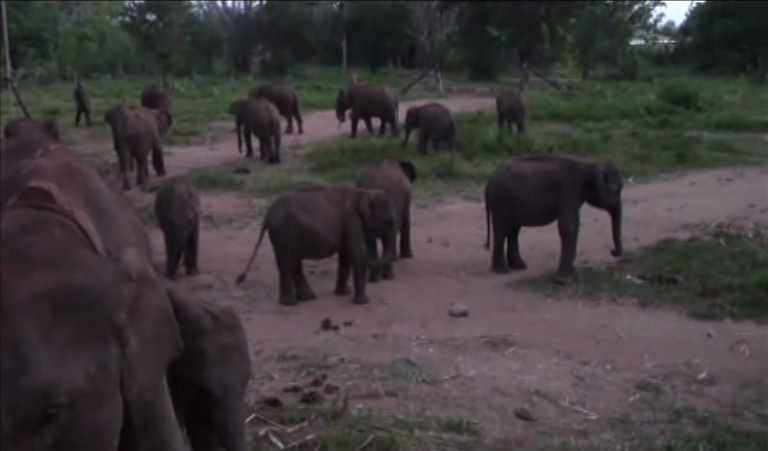
Seven baby elephants released to Udawalawa

Seven baby elephants who have been raised for five years at Udawalawa Eth Athurusevana have been released to Udawalawa National Wildlife Park under the patronage of Minister Gamini Jayawickrama Perera. Baby elephants who meet with various injuries, are being brought to Udawalawa Eth Ahurusevana, and provided treatment and protection. Seven baby elephants who were looked after for five years at Eth Athurusevana were released to the Gonaviddagala area of Udawalawa National Wildlife Park. Four of them were released this morning after religious activities. The other three were released this afternoon. A group of officials including the Wildlife Director General S.K. Pathirana were present on this occasion.
Source – 10/06/2017, ITN News,See more at – https://www.itnnews.lk/local-news/seven-baby-elephants-released-to-udawalawa/
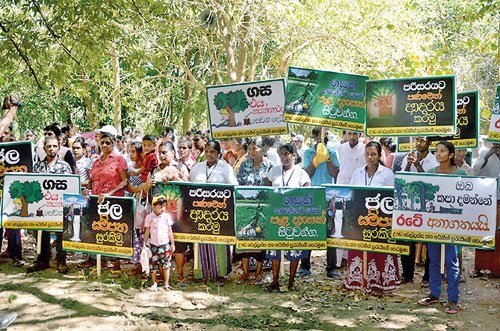
Bitter protests over sugar cane
Protests are growing over a private sugar cane cultivation in Dehigama, Rideemali-yadda, where lands from the Madhuru Oya forest will be allocated. Environmentalists and villagers conducted a religious ritual to protect the trees of the forest. According to their belief the trees cannot be felled after these religious observances are held.
A large number of Buddhist priests visited the Madhuru Oya forest amidst chanting of seth pirith to perform the ritual. The trees were draped with robes and ordained as part of the ritual. More than 62,000 acres are to be allocated for the sugar cane plantation.
Pix and text by Nayanajeewa Bandara
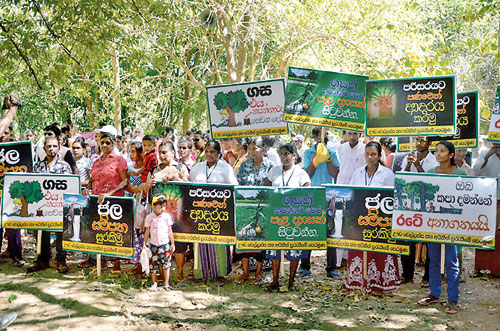
Protesters say sugar cane cultivation will affect water supply
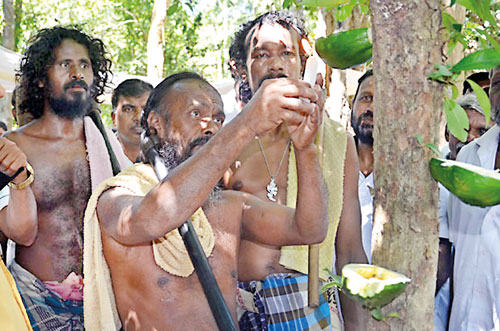
A member of the indigenous clan lights a makeshift lamp affixed to a tree
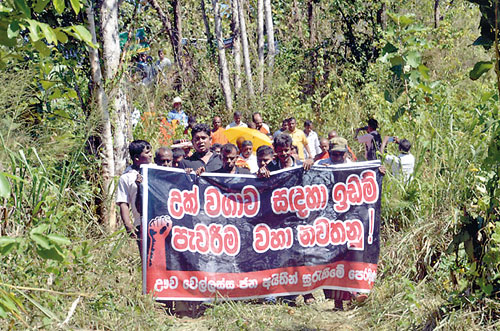
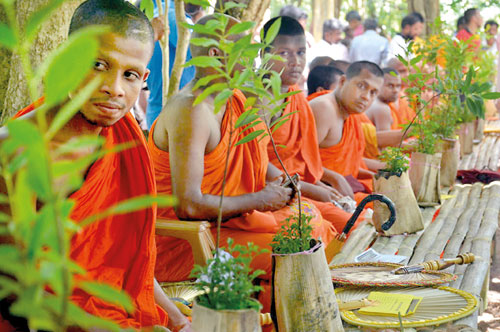
Young monks prepare to plant saplings
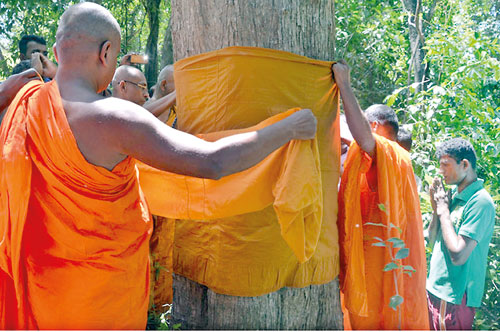
A monk drapes a saffron coloured robe on a tree
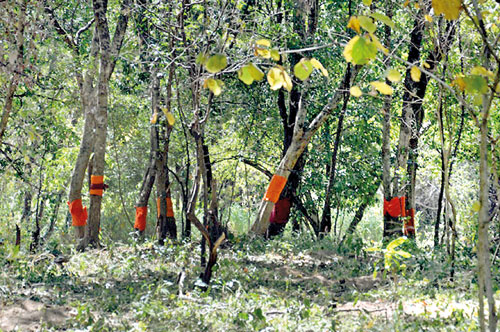
The trees in the forest are draped in saffron robes as part of a religious ritual to protect them from being felled
Source – 11/06/2017, The Sunday Times, See more at -http://www.sundaytimes.lk/170611/news/bitter-protests-over-sugar-cane-244794.html
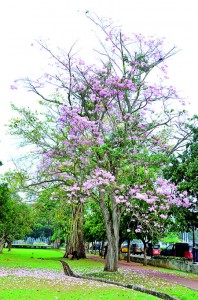
‘I think that I shall never see a poem lovely as a tree’
Our political leaders seem to admire and take Singapore as a model. Yet, consider how much planning, resources and energy have gone into branding Singapore as the garden city. They would have started from scratch and amidst all that concrete and high rise construction in a limited space, Singapore’s leaders have done admirably to create an empathy in their people for the planted natural surroundings and their care. It is also high diplomacy because Singapore depends heavily on tourism and needs to keep constantly adding to its attractions.
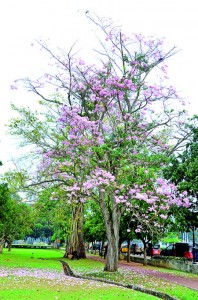 Here, just look at the splendour we have inherited, the giant Flamboyants showering red and orange flowers on pavements, the yellow Ehela hanging down in clusters, the Mara trees also shedding gold on the concrete below, not to mention the ubiquitous Araliya and Bougainvillea in all colours. Have you seen just now the pink of the Tabebuia is beginning to show, pleasing to the eye amidst the grey clouds and rain . Yet why do we not appreciate these gifts of nature – only a few committed stalwarts like the Ruk Rakaganno organisation is dedicated to “protect the trees” amidst all the drive to cut them down for more concrete and asphalt!
Here, just look at the splendour we have inherited, the giant Flamboyants showering red and orange flowers on pavements, the yellow Ehela hanging down in clusters, the Mara trees also shedding gold on the concrete below, not to mention the ubiquitous Araliya and Bougainvillea in all colours. Have you seen just now the pink of the Tabebuia is beginning to show, pleasing to the eye amidst the grey clouds and rain . Yet why do we not appreciate these gifts of nature – only a few committed stalwarts like the Ruk Rakaganno organisation is dedicated to “protect the trees” amidst all the drive to cut them down for more concrete and asphalt!
Why is that people no longer care for and know about the trees around them? Trees are living entities which are connected to all life forms. What damage we do to trees will eventually impact us all.
The National Trust has invited experts to publish coffee table books on Flowering Plants and draw attention to what is Growing in the Garden. These books have much value for our country’s promotional efforts but the tourism authorities seem unaware of our natural wealth and only pursue the monetary goals. How many of our VIPs have considered giving these books as gifts instead of the token package of consumable tea ? In contrast, in all my diplomatic postings, the gifts from the highest in the land usually consisted of glossy coffee table books highlighting their country’s heritage. The National Trust is supporting a project to publish a book on heritage trees and to nameboard and conserve all the heritage trees in the vicinity of Colombo. It is a project which the Municipality and the UDA all should support, because in truth we are a city in a garden. However, the situation is so bad that some say don’t name the trees because once observed there is a value, it will be cut down!
Singapore has turned its Botanical Gardens into a World Heritage site with all the research, financing and diplomatic skills involved, in order to enhance its country brand and tourism appeal. Here, in Peradeniya we have one of the oldest botanical gardens in Asia with a heritage going back to the ancient kings and modern assets of research, education and public amenities. Have we even taken one step to putting this treasure on the world map? There is a wonderful collection in the Arboretum of botanical specimen paintings (some of which are in Singapore) by a talented family of Sri Lankans going back several generations – why have these paintings not been published?
Some years ago, retiring from the diplomatic service, I had begun to work on a book on the gardens of Sri Lanka, unaware at the time of the rich heritage and variety of gardens in the country. At the time, my colleagues were sceptical and kept asking what is the connection between gardens and diplomacy? Yet in truth, in ancient times, gardens were the site of most diplomatic meetings, assemblies and functions. Mauryan Emperor Ashoka was known to hold public hearings in gardens much like the town hall meetings today. In this week of Poson we recall that the Sri Lankan King met Emperor Ashoka’s envoy Mahinda Thera in Mihintale. From the Mahawansa we can gather that this was not a chance meeting as in legend but probably pre-arranged in a garden of mango trees ( amba vanaya). The Mahawansa also relates that the first public sermons on Buddhism were pronounced in the palace gardens in Anuradhapura, (the elephant stables had also to be cleaned out to accommodate the huge throngs of people who came to listen) and the royal forest park was offered and accepted as a residence to the visiting high level delegation of monks.
Sri Lanka’s garden heritage includes a number of ancient monastic gardens, probably unique in Asia.These sites, carefully preserved by the Archaeological Department include Kaludiya Pokuna of which much has been written. Now it seems that some foolish Minister has actually conceived of a plan to turn it into a tourist hotel, over the objections of the Archaeological Department . There are rumours that an ancient frieze has already been damaged in the process. It seems our heritage treasures have no value for these ambitious politicians who only seem to want to make more money – shame!
Carefully preserved and protected heritage sites can be economically viable as numerous studies have shown. Yet when the thirst for revenue overcomes the care for managing the site properly, it can all end very badly. Pinnawela is one such project once born to protect the abandoned baby elephants now reduced to a circus for the tourists, displaying techniques of bottle feeding to one or two young elephants and in another corner one chained elephant being force-fed by tourists who buy baskets of fruit for this purpose. It’s surprising that the supervising vets have allowed these things to happen, completely defying the purpose for which Pinnawela was set up.
Today our public gardens are indispensable sites providing the “green lung” of the city and enabling recreation, rest and recovery from the urban confusion and pollution. So why is it that the Vihara Maha Devi Park for example is not showcased as a city asset where our foreign delegations should be invited to visit and walk around, like a museum? Those who are regular visitors for exercise in Vihara Maha Devi Park know the value of this great spot in the city, including the fascination of the younger generation for the resident bat colony. We need to give credit to the previous government for bringing down the railings and making the park a living part of the city.
Gardens, with the calming effects of harmony in nature, also serve to create peace after conflict. Imagine how much better would be a garden for people to come to terms with grief than a monument of cement and stone? In many other parts of the world, commemorative peace gardens are being created or re-born like the ancient rose garden in Kabul, reminding of how nature can help human beings reconcile with death and pain. So why not a peace garden in Jaffna with local trees and plants where grief, irrespective of race or creed, can find solace.
Source – 11/06/2017, the sunday Times, see more at – http://www.sundaytimes.lk/170611/plus/i-think-that-i-shall-never-see-a-poem-lovely-as-a-tree-244283.html
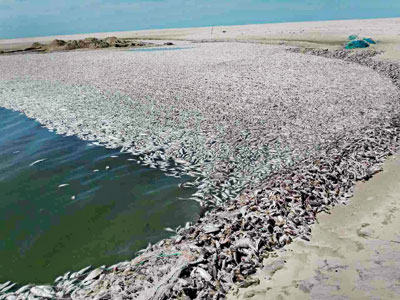
Nandikadal lagoon fish perished without oxygen, says NARA
Nandikadal lagoon fish perished without oxygen, says NARA
By Malaka Rodrigo
Thousands of fish seen floating in the Nandikadal and another nearby lagoon in Mullativu this week died because of a lack of oxygen, experts say.
Nandikadal is where a decisive battle against LTTE terrorism took place in May 2009. So the news of the dead fish triggered more curiosity.
The Fisheries Ministry directed the National Aquatic Resources Research and Development Agency to investigate. One June 4, a team led by NARA’s head of Environmental Studies S A M Azmi visited Nandikadal.

Sea of dead fish. Pic by Thayalan
“Different species of fish ranging from shrimp, eels to modha were found in the mass fish grave. We tested the water in the lagoon and found that the oxygen level is zero in the affected section of the lagoon. So literally, these fish died due to depletion of oxygen in the water,” Mr Azmi revealed.
They did not find any bacterial infection.
He also pointed out that this is a common phenomenon.
The water level of the Nandikadal lagoon had dropped below the sand bar as a result of the drought and this prevented the flow of water between the sea and the lagoon.
“Usually a sudden rain that brings lot of nitrogen and fertilizer to a water body triggers an algal boom – a rapid growth of microscopic algae. The algae soon die and the decomposition process consumes a lot of the oxygen dissolved in the water rapidly depleting the lifeline of the fish in the water. Once in a while fish in Beira lake and other inland water bodies, too, die due to this phenomenon according to the NARA expert. The area in Mullativu got some rains on the 29th of May, but there was little time for such algae bloom,” he said.
Mr. Azmi believes disturbances of the bottom sediments due to activities such as fishing could have triggered different oxygen consuming processes that led to the sudden depleting of oxygen in the Nandikadal lagoon. He said it is rarely that they record a zero oxygen level in a body of water, adding that even in cases of fish deaths in other areas due to low oxygen, the level is not zero.
The NARA team advised that a section of the sand bar be excavated to let the sea water flow into the lagoon.
Mr Azmi said the NARA team heard from locals that this is a common occurrence at this time of year. “So it is advisable to cut this barrier every year around the 15th of May,” Mr Azmi said.
This could happen in shallow coastal areas as well. These areas are called ‘dead zones’ resulting in deaths of fish in the open ocean as well.

Source – 11/06/2017, The Sunday Times, See more at – http://www.sundaytimes.lk/170611/news/nandikadal-lagoon-fish-perished-without-oxygen-says-nara-244783.html



